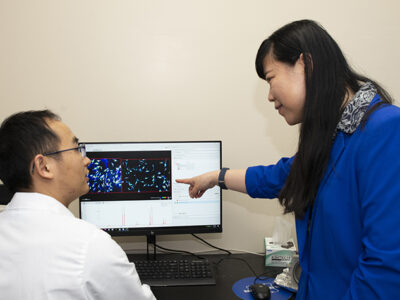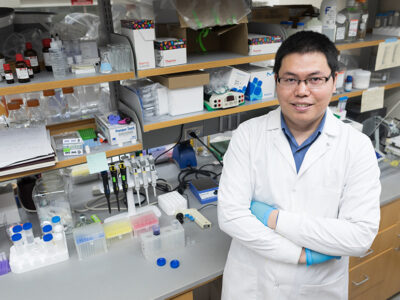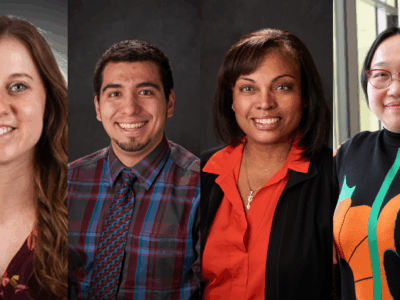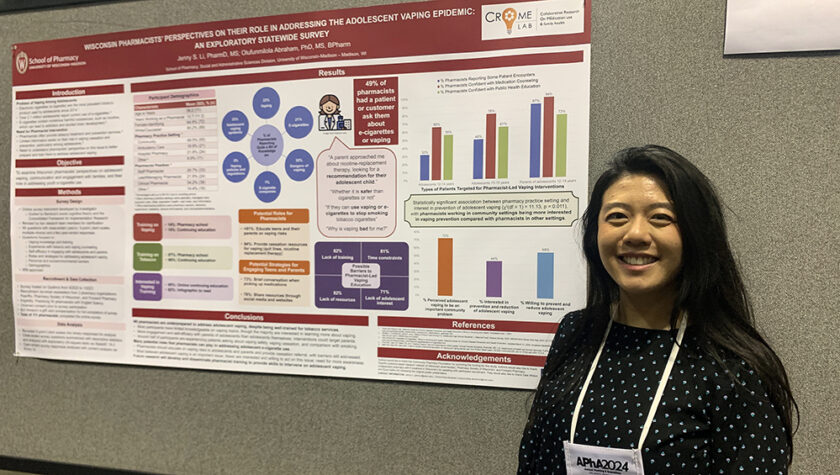
6
June

In the CRoME Research Lab, Associate Professor Olufunmilola Abraham and alum Jenny Li develop an educational tool to enable pharmacists to partner with parents in addressing teen vaping
By Logan Underwood
Over 14 percent of Wisconsin high schoolers have admitted to vaping in the past month. This startling statistic is just one important fact presented in the CRoME Research Lab’s Pharmacist-led E-Cigarette and Vaping Resource (Ph-EVER).
Olufunmilola Abraham (MS ’11, PhD ’13), associate professor in the University of Wisconsin–Madison School of Pharmacy’s Social and Administrative Sciences Division who leads the CRoME (Collaborative Research on MEdication use and family health) Research Lab, and Jenny Li (MS ’22, PhD ’24) created the Ph-EVER to leverage the expertise and accessibility of pharmacists to tackle the vaping epidemic.
“My brain is all about how pharmacists can do more in the community, do more in the adolescent phase, and do more in helping parents connect with their kids around substance use or medication use,” says Abraham.
“My main line of research has been in examining the perspectives of teenagers, parents of teenagers, and pharmacists on what they think pharmacists could potentially do to address the vaping epidemic that we have in the United States,” says Li.
The process of discovery
The partnership between Li and Abraham first began when they worked on research together at the University of Pittsburgh, where Li earned her PharmD and Abraham served on the faculty. After graduation, Li enrolled in the UW–Madison School of Pharmacy Health Services Research in Pharmacy PhD program, and Abraham joined the School’s faculty in the Social and Administrative Sciences Division.

As a graduate student on Abraham’s CRoME Team, Li’s research was focused on vaping, specifically in adolescents. For her master’s thesis, she surveyed and interviewed 30 pairs of teenagers and their parents to understand their perspectives on learning about vaping. Findings from this study laid the foundation for development of the initial version of the Ph-EVER handout. This resource, geared toward adolescents and parents, included possible side effects of vaping, tips on how parents can talk to their kids about vaping, and resources for quitting.
For the next phase of her research, which was supported by a grant from the Community Pharmacy Foundation (CPF), Li partnered with the Pharmacy Society of Wisconsin (PSW), Forward Pharmacy, and PearlRx — a practice-based research network collaboratively managed by PSW and the School — to survey 111 pharmacists and interview 30 pharmacists from around Wisconsin. Li assessed the participants on their perceived knowledge of vaping and what training or education they had received on the topic. Additionally, pharmacists gave input on what strategies they could implement to address adolescent vaping in their own practice. Pharmacists interviewed were also asked for feedback on the Ph-EVER.
With funding and support from a Baldwin Wisconsin Idea Seed Grant, Li then interviewed 46 pairs of parents and teens and asked for feedback on how to improve the Ph-EVER handout.
“With the feedback from pharmacists, parents, and teens on the Ph-EVER handout, we made a revision and made two versions: the parent-facing one and a teen-facing one,” says Li.
The second version of the Ph-EVER (Ph-EVER 2.0) is split into two separate handouts to better connect with the specific populations of parents and teens. The parent handout focuses on how to detect signs of vaping and tips on talking to children about the issue, while the teen resource includes resources for quitting, images of a lung damaged by vaping, and both long-term and immediate consequences of vaping.
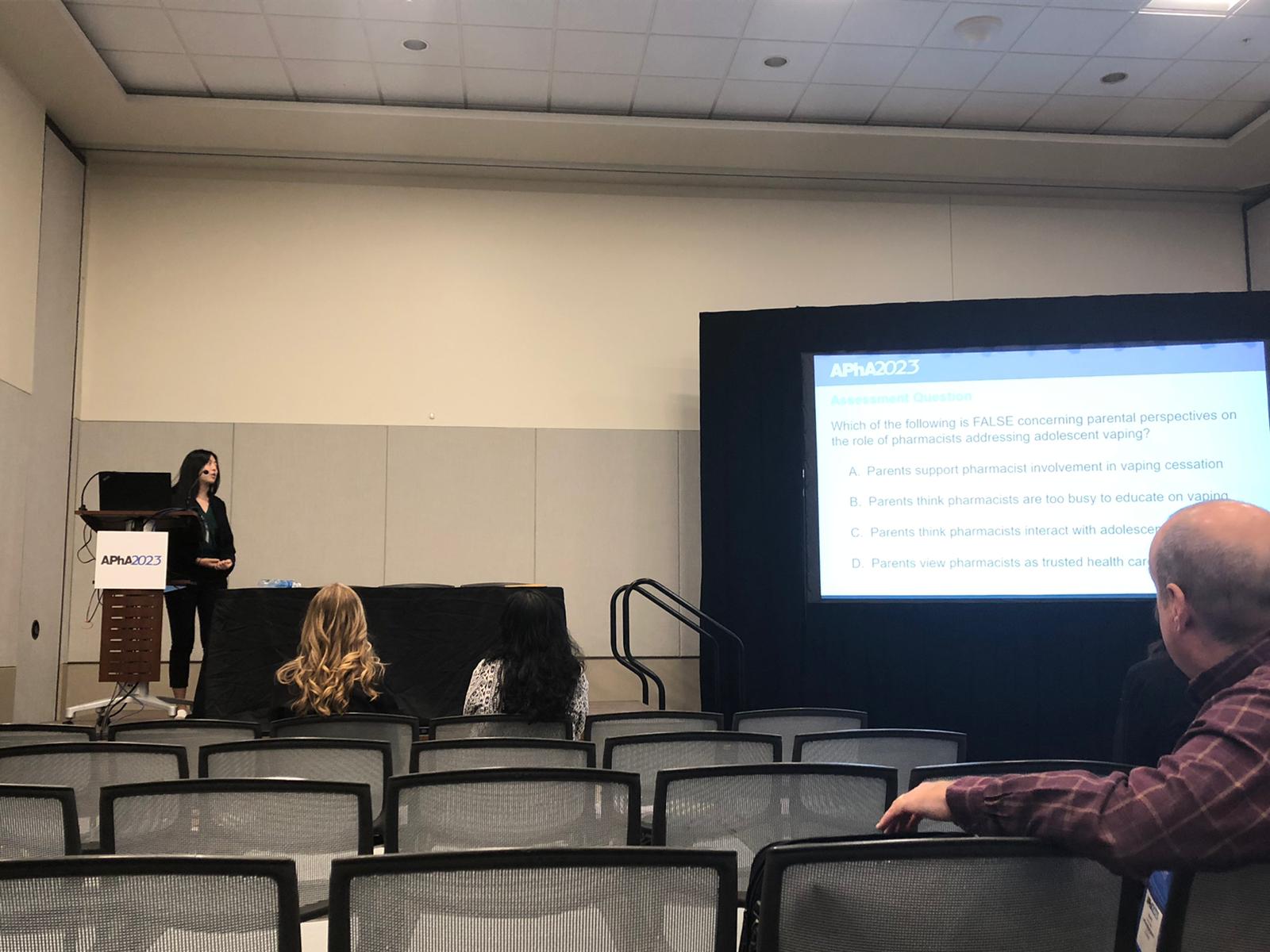
With funding from the CPF, Li surveyed 35 pairs of parents and teens recruited from pharmacies across Wisconsin to assess their knowledge and attitudes on vaping before and after reviewing their targeted version of the Ph-EVER 2.0. They were also interviewed for additional feedback on the Ph-EVER 2.0 and how pharmacists could share this resource with them.
Soon, Li will be publishing more findings from the pharmacist interviews (co-authored with PharmD students Ellie Maday and Annika Brekke) and the teen interviews on their version of the Ph-EVER 2.0 (co-authored with PharmD students Grace Klubertanz and McKennah Matulle).
Overall, Li says that teens, parents, and pharmacists appear mostly open to and supportive of pharmacist-provided education and intervention on youth vaping. Through either educating and empowering parents to communicate with their children about vaping or directly speaking to teens at local schools on vaping, pharmacists have a clear role in the prevention of adolescent vaping.
The CRoME Research Lab is currently in the process of analyzing the survey data from these pre-post surveys. Li hopes that the analysis of how attitudes and knowledge on vaping change after being exposed to Ph-EVER 2.0 to continue to revise the handout to be as effective of a tool as possible.
“I would love to be able to take the feedback that we got to make a third version, a Ph-EVER 3.0,” says Li.
A new role for pharmacists
As the Ph-EVER evolves, Li is considering ways to most effectively disseminate the information across Wisconsin pharmacies, even considering enlarging the handout to display the information directly in pharmacies. The poster could have a QR code, so patients would easily be able to share and carry the information with them. Other pharmacists suggested implementing the QR code as small cards that could be handed out to patients or slipped into prescription bags.
“Pharmacists are well-positioned to spread awareness of the dangers of vaping within their patient communities,” says Li.
Pharmacists already support patients who are trying to quit smoking by providing access to nicotine replacement therapies and smoking cessation counseling. And that same opportunity exists for patients hoping to nix vaping, despite a dearth of research.
“This work is impacting a lot of teams and a lot of parents and families. Pharmacists show us they want to be educated on this so they can support the community.”
—Olufunmilola Abraham
“There’s not a lot of research on vaping, because it’s so new,” explains Li. “It only became a really popular tobacco product in the mid-2010s.”
Abraham and Li are aiming to fill that research gap, having presented their findings at the American Pharmacists Association Annual Meeting in both 2023 and 2024.
“This work is impacting a lot of teams and a lot of parents and families,” says Abraham. “Pharmacists show us they want to be educated on this so they can support the community.”




